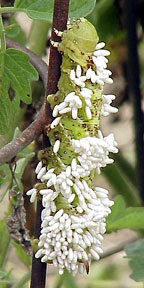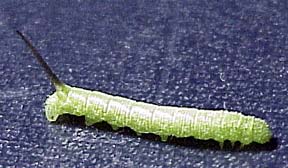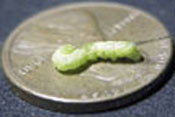Tomato Hornworm

Photos by:
Steve Nearman
If you see one like on the left, just move it away from your garden and let it live. When the wasp eggs on its back hatch the larve will eat the Hornworm then mature to lay many more eggs on other Hornworms. The little critter below is the same one as below on the penny. He was found on my shirt after working the garden one day.

Hornworm eggs are laid singly on leaves. While both species of hornworms have a large horn on the posterior end of the body, the tobacco hornworm has seven diagonal stripes on each side of the body in contrast to the tomato hornworm, which has eight chevron-shaped stripes. Larvae feed for 3 or 4 weeks, then burrow into the soil to pupate. The adult moth is a strong flier with a wingspan up to 5 inches (12 cm). Development takes about 2 months in summer; the winter is passed in the pupal stage. There are two generations a year in most areas; larvae are usually most common in midsummer, but there may be a small population peak in late summer. Infestations tend to be more severe in warm inland areas.

Baby Hornworm on a US penny.